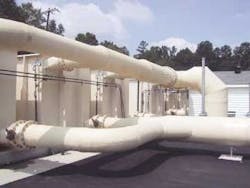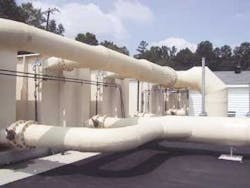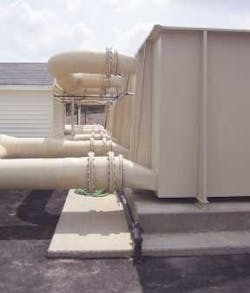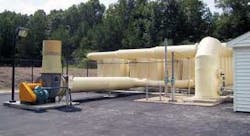Management at Jefferson County (AL) Environmental Services reports it has solved a long-running odor problem by tapping a 30,000 cfm-capacity biofilter array into a 14 mgd average, 55 mgd maximum sewage transfer line. The 6-unit BASYS™ array was manufactured by Biorem Technologies Inc. of Guelph, Ontario.
The array handles hydrogen sulfide at average concentration of 5 ppm, and maximum of 25 ppm, as well as other odor-causing compounds, such as methyl mercaptan, dimethyl sulfide (DMS), dimethyl disulfide (DMDS), and other Total Reduced Sulfur (TRS) compounds. The county has ordered five additional systems from the manufacturer for one of its wastewater treatment plants.
"Our main purpose was to stop the dozens of odor complaints we received over four or five years where the transfer line ran near a shopping mall and a residential area," said Clyde C. Osborne, wastewater treatment plant superintendent. "Helping to reduce corrosion that was found during a routine inspection was a welcome by-product. When you go to that site now, you don't smell anything. Once the system became fully operational, the complaints stopped."
Osborne said a high-stack exhaust fan had apparently been solving the problem up- and downstream of the sensitive area for about seven years, but complaints had persisted in the immediate area, stimulating a search for an alternative solution.
"We considered activated carbon towers, which we had used at a pretreatment facility upstream, but we didn't like the expense of having to change media every three or four years, or the need to dispose of a hazardous material," he said. "That led us to biological filtration, with presentations from three vendors. Biorem was chosen because their media was more uniform, and didn't seem to present risks of filter clogging or attracting rodents."
"Construction started early in 2002, with a local contractor able to handle the installation. Startup was in August 2002, with media expected to last for 10 years. We're expecting a low-maintenance, long-running solution to the problem. They provided sample testing three or four times the first year, and then we contracted for more, and haven't seen any problems."
The 60 inch, 35-mile concrete transfer line, built in 1987, receives effluent from about one-quarter of the system's 164 pump stations, which range in capacity from 100,000-5,000,000 gpd. Corrosion had been enough of a problem to require activated sludge pretreatment, upstream from the odor complaint area, that was related to input from dairy product and soft drink plants.
Consulting engineering services for the odor-control project were provided to the county by F.W. Daugherty Engineering & Associates of Birmingham, AL.
The odor control system operates under negative pressure, with a main collection duct evacuating the headspace of a subterranean junction box that receives discharge from the transfer line. Air is also received from other sewer lines emptying into the box, thereby adding some corrosion control benefit.
The collection duct branches above ground to the biofilter array. Flanges on the duct provide for pre-conditioning of the air via a pneumatic humidification manifold prior to its entry to the biofilters. Treated air leaving the biofilters is drawn out through the stacks of fans for discharge to the atmosphere. A shed enclosure houses the complete humidification system, including compressors, pumps, and all instrumentation and controls.
The biofilter array is set up as two units handling 15,000 cfm each, with separate exhaust fans. Normal deployment is for redundancy against operational interruption, with simultaneous operation available for maximum removal of hydrogen sulfide and other odor-causing TRS compounds. Continuous monitoring of hydrogen sulfide in the entering air guides the level of operation.
Biorem provided six of its 5000 cfm BASYS integrated modular biofilter units. Capacity could be added by connecting more filter modules. Quarterly, preventive-maintenance media testing, within a 10-year contract program, has already begun.
The testing program consists of measurement of critical parameters such as pH, nutrient levels, and bacterial and fungal speciation and enumeration, as well as physiochemical properties such as moisture content and particle size. The company maintains that such testing has been a critical factor in achieving continuous, reliable performance for any biofilters, and says it has over 80 installations of its biofilters in North America.
The company adds that its Biosorbens™ biofiltration media, also suitable for VOC removal, was designed specifically to handle a wide range of odor-causing compounds, including TRS and others, as opposed to the traditional focus on hydrogen sulfide only.
"It's important to remove all odorous compounds, because these additional ones are a significant contributor to odor complaints even when they are present in minute amounts," said Derek Webb, P.E., the company's director of design and production engineering. "This is because they have very low odor detection thresholds, such as dimethyl sulfide at 0.0001 ppm; crotyl mercaptan at 0.000029 ppm; and ethyl mercaptan at 0.00019 ppm."
The media is said to maintain a balance between optimal growing conditions for the microbes, while offering ideal pressure drop through the media, high moisture retention, long operating life, and resistance to decomposition and compaction, while providing a surface on which the biomass film can flourish.
It is described as consisting of inert, uniformly-shaped hydrophilic cores that are produced with nutrient-rich organic and inorganic adsorbents. These characteristics are said to decrease residence time, and increase serviceable life to more than 10 years. Its high surface area-to-volume ratio is said to result in requiring only one-third the space needed by organic medias.
For further information, contact the website of Biorem Technologies at www.bioremtech.com.






